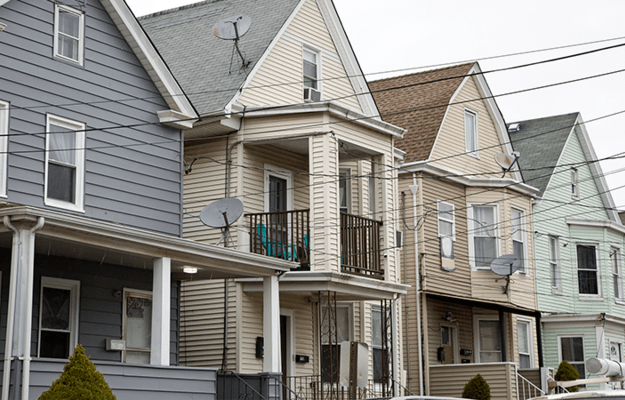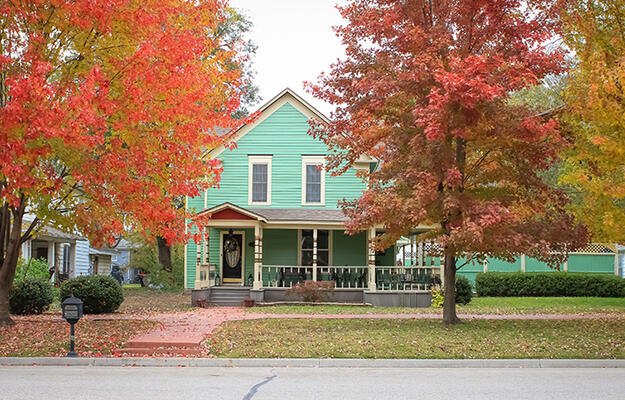
Alex Potemkin, Getty Images
PUSH Buffalo’s Transformational Investments in Local Resilience Unlock Economic Opportunity
Today, nearly half the nation’s housing stock faces severe threats from increasingly frequent climate change–fueled events, such as extreme storms, hurricanes, wildfires, floods, and tornados. Older, poor-quality homes are especially vulnerable to such events, as is the well-being and health of their residents. In the face of this challenge, some local organizations are proactively addressing these vulnerabilities and creating economic opportunity through investments in climate resilience, which is the ability to anticipate, prepare for, and respond to extreme weather events or climate trends.
People United for Sustainable Housing (PUSH) Buffalo, a community-based housing developer and advocacy organization, is advancing two initiatives—School 77 and West Side Homes—to improve housing quality, lower energy costs, and create job opportunities in a region of Buffalo with high rates of both poverty and unemployment. Located within PUSH’s Green Development Zone, a 25-square-block area where PUSH concentrates investments in green and affordable development, these projects are important examples of how community-driven investments can address root causes of vulnerability to climate shocks, such as flooding and extreme heat events in the city, and unlock important economic and social benefits.
PUSH established School 77, a mixed-use sustainable building, in 2018. Conceptualized in a three-year community-engaged planning effort, this formerly abandoned public school was developed into a climate-resilient, multiuse site that provides affordable senior housing, a community theater, nonprofit office space, and an after-school space for neighborhood children and young people.
In addition to the social and economic benefits these amenities provide for community members, the structure incorporates features including a green roof, solar panels, and green infrastructure installations. These make the building both more climate resilient and more energy efficient for residents. Surrounding School 77 are the West Side Homes, 49 dispersed affordable rental units that are a mix of renovated units and new construction. Most of the units meet Net Zero or Passive House requirements, providing safe, affordable, and energy-efficient residential options.
To strengthen climate resilience and unlock community benefits from these projects, PUSH employs three key strategies:
- Center community in planning and implementation. As a membership-based nonprofit, PUSH is fueled by its community engagement. It holds monthly meetings with community members, soliciting local ideas and priorities on vacant lot reuse and advocacy efforts, as well as an annual Community Planning Congress (CPC). The idea for School 77 was born out of the CPC, and PUSH continued to engage the community throughout the proposal development and implementation processes. Many West Side residents shared their desire to buy shares of the solar power generated at School 77, so PUSH incorporated a community solar farm into the project design.
- Leverage diverse funding sources. PUSH finds resourceful ways to ensure investments are affordable to residents, which often requires stacking and braiding federal, state, and local financing. They blend low-income housing tax credits, which incentivize the development of affordable housing; funding from New York State’s Block by Block Homeownership Program—which provides funding for small, new infill projects on vacant land in underutilized parts of five priority cities; funding from the Green Jobs–Green New York Program, which offers low-interest financing for energy-efficient upgrades; and philanthropic investments. Because their projects often include an innovative mix of housing, workforce, and green components, they’re eligible for multiple types of funding that can be leveraged for maximum impact.
- Invest in the local economy. PUSH ensures local development benefits local residents by employing and training residents to do much of the work required for the projects. They created a sustainable workforce training center, where residents are paired with experienced contractors and trade organizations, to create a local pipeline for workforce development and skill building. This means residents capture the economic and workforce development benefits from constructing the projects, as well as the social and quality of life benefits they can access once these projects are built. To ensure residents can access the benefits from these opportunities, PUSH’s equity-centered= approach to workforce development also includes providing GED completion supports, child care services, and transportation services.
Given recent uncertainty regarding federal investments to support resilience efforts in communities like Buffalo, state and local governments and philanthropic donors can fill funding gaps to ensure this critical work can continue. Against this backdrop, local and state action through expanded financing tools, grantmaking and lending, tax incentives and rebates, capacity building and technical assistance, and other means will be more vital than ever for local organizations like PUSH to succeed.


